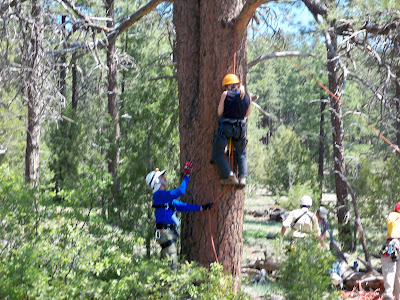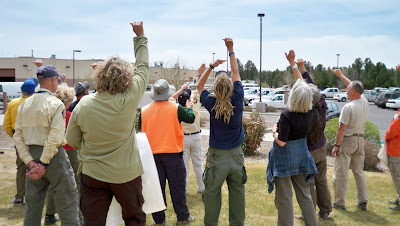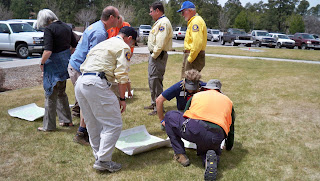As part of the hasty team, Sueanne (in black) prepares to rappel down to one of the two patients to asses his condition. Meanwhile, another member of the hasty team (not in the picture) rappels to the second patient...
Scott works the 540 belay....


These are my stories as a volunteer member of the Sheriff's Search and Rescue team in Coconino County, Arizona. I'll share what it's like to go from a beginner with a lot to learn to an experienced and, hopefully, valuable member of the team, as well as the missions, training, and other activities along the way.
About Coconino County
Encompassing 18,661 square miles, Coconino County, Arizona, is the second largest county in the U.S. but one of the least populated. Our county includes Grand Canyon National Park, the Navajo, Havasupai, Hualapai and Hopi Indian Reservations, and the largest contiguous ponderosa pine forest in the world. Elevations range from 2,000 feet above sea level along the Colorado River to 12,633 feet at the summit of Mt. Humphreys in Flagstaff.
Disclosure: Some of the links on this site are affiliate links, and I may earn a commission if you click through and make a purchase.

Have I mentioned that I'm a bit afraid of heights? Well, make that afraid of "exposure" more like. Either way, being suspended 100 feet above the ground between two sides of a canyon isn't exactly within my comfort zone.
But that's where I found myself on Saturday, with some of my technical rescue teammates on one side of the canyon at Paradise Forks, lowering me, and the others on the opposite side, raising. There was a main line and a belay line on either side, with me somewhere in the middle, hanging while attached to all four ropes.
I could have said no. More than one of my teammates said, "Deb, if you don't feel comfortable with this, no problem. You don't have to do it." I may have hesitated at that suggestion for a split second, but I said, "No, I'm fine with it."
I tried my best to look and sound at ease. Besides, it's better I do it—go over the edge—as much as possible, to get more comfortable with the skills and with the feeling of trusting my life to gear and teammates.
And I couldn't be safer than with SAR. We do things carefully, with redundancy and with safety checks. As I was tying into the main and belay lines, a teammate was watching closely. Then I was checked over by three other experienced people—everything from my seat and chest harnesses to my caribiners and knots. The safety officer for the exercise also checked all anchors and main line and belay setups. Then, when all team members were ready, I walked off the edge. Wheeee!
Truth be told, it was actually quite fun. A teammate later told me I had a bit of a "newborn giraffe" look when I was temporarily set down on a pinnacle around mid-canyon, but I soon got my feet under me and stood up on my own. Then I was once again lifted and brought the rest of the way across the canyon. It turned out to be a very smooth ride.
One very useful, real-world example of how this maneuver would come in handy would be if, say, a victim were stranded on some sort of pinnacle like the one where I was briefly set down or on the top of a vehicle trapped in swiftwater. A rescuer could be lowered and suspended to a point somewhere between two stable sides, to where the victim is located, do a pick-off or package a patient in a litter, and then be raised along with that victim to either side.
This Saturday's tech team practice also included working with a guiding line, used to keep rescuer and rescue-ee away from rock walls and obstacles, making the lower and raise easier on both. I thought these setups were pretty fascinating, and I was excited to be part of them and to find that I could actually be useful. By George, I'm learnin' me stuff!
I've honestly been nervous that I wouldn't remember some of the basics when we'd move on to more advanced skills, even though I've been practicing those basics on the side. But I now realize that the basics come into play all the time. They're a foundation for the more advanced skills, so I get to use them even as we advance to more complex maneuvers. I find this all pretty exciting, though I still not have the nerves. And maybe that's a good thing. Getting too comfortable can lead to errors, so I've heard and read.
Other than training, we've also had a couple of call-outs. One ended quickly when a teammate who responded directly to the last known point (LKP) because he lives nearby, found the subject soon after he started searching. Not a happy ending, I'm afraid.
Then, last night, our team was called to assist Navajo PD in locating an overdue hunter on the reservation. The man was found... well, he found us... and was just fine. In fact, he was wondering who we were all looking for. Just a case of miscommunication with the reporting party, so it seems.
Oh, and finally (for now), on a recreational note: I recently went on a great hiking and car-camping trip to northern Arizona and southern Utah in the Paria-Vermillion Cliffs Wilderness Area, where I visited a place called White Pocket and the now internationally known Wave. Here's one of the many photos I took of the Wave before my camera went kaput (again):
Kay was such a good sport! She and Jerry, the other lost subject, had to sit around a long time before they were found. At least it was a warmer-than-usual fall day.
I'm back. And, hopefully, I'm now a better tracker after an another 16 hours of instruction, this time at the SAR City conference in Barstow, California, where there were more than 50 classes offered on a wide range of topics and skills. This annual conference is organized and hosted by the all-volunteer Barstow Desert Rescue Squad in San Bernadino County.
I thought the three-day event was well worth the trip, and as always, I really enjoyed meeting people from other teams, especially the folks from Dolores, Colorado, K9 Search & Rescue, who came over to introduce themselves soon after I arrived as I sat alone by my tent. So, thank you Shawn, Chuck, Randy, Vicki #1, Vicki #2, and Kimberly (and Jack!) for hanging out with me over the weekend. It was great to meet you and learn about your team. And it was nice meeting you too, Orange County guys. That's a spiffy Hummer you've got there.
As for that tracking class—which was excellent in many ways, and the lead instructor, retired sergeant and SAR coordinator Darryl Heller was top-notch—it's always interesting to learn the same skills from different people. I pick up new techniques and "tricks" and get at least a somewhat different perspective, which I think is really valuable.
That said, it's a challenge not to say "yes, but.." when an instructor tells you that what you learned from someone else is wrong ("No, you never do that" was the reply to a question I asked about a method of measuring stride that I'd been taught at the Heber, Arizona conference), or if that instructor has a very different way of doing something than you're used to.
Not that I'm the greatest tracker after just two years in SAR and five tracking classes, but it can also be difficult to swallow your pride when someone talks to you like you have no experience at all. In my case, during one of the field sessions, I was used as an example of what NOT to do, even though it's something my own team does when tracking, and I've learned it from others as well. I must admit, that really bugged me... even after the field instructor came up to me after class to say it had been he who'd encouraged the other students in my group to do something that obliterated part of the track and that I hadn't actually done anything wrong. Well, phooey, I wish the other students knew that.
Other than that, though... I thought the class was great and would highly recommend it to anyone in SAR. And while that class took up the entire conference, I heard lots of good things about many of the other classes, too, some of which lasted an hour or two or four and others that spanned the whole weekend.
If you'd like to read more about the conference and see my photos—I wish I'd taken more, but I was usually too busy with the class or yacking to remember to take pictures—I did a write-up about it here: SAR City: A Search and Rescue Conference in Barstow, California.

It was at that time, around 3 p.m. Saturday, when there was a call-out for a lost 15-year-old, so I left my group with the other instructor and quickly hiked back to the road, where another teammate scooped me up and we headed to the SAR building.
That mission was quickly concluded when some tracks were discovered and then the DPS helicopter spotted the girl, and we returned to the SAR building just before 5:00. Ten minutes later, I was off to Williams. So it had been all day Saturday in GPS class, then to the mission for the lost girl, then to Williams for the overnight road block, then to the tracking class on Sunday. And today, Monday, is a continuing evidence search. Whew! But I did get a good night's sleep last night, so I'm ready to search.
Oh, and I practiced rappelling last week, too, with a couple of my tech rescue teammates. As usual, I was nervous going over the edge the first time through, but when I hiked back up and went for a second and third descent, my nerves calmed (also as usual). We were using a conditional self-belay on a second line, which meant I didn't have a free hand to brace myself against the rock, like I usually had before. So, that was a little different for me.
Here, you can see the brake rack in my right hand, while I tend the Prusik with my left. It was about a 30-foot cliff. Maybe not a lot... but enough.
Yyyaaayyy! I'm a very happy—and very relieved—SAR girl. I had test anxiety all last night and this morning before I began demonstrating my new technical rescue skills, as my experienced teammates watched at each test station. I had no idea how it all would go, but I'm happy to report that... well, I didn't suck. 💪 😃
I started off at the patient packaging and litter rigging station, moved on to ascending and rappelling with a hot changeover on the rope, and then went to the pick-off station. (A pick-off is what you do when someone is stranded over the edge, either on a rope or unsupported, perhaps clinging to a rock face.) Next, I set up belay systems, anchors, and mechanical advantage systems and then tied a bunch of different knots and a load-releasing hitch. I had to explain a pretensioned back-tie, make improvised chest and seat harnesses, and be checked for having the required personal tech gear.
When I had gone through all of the testing stations, the instructors had marked off and signed my entire checklist. Phew! Then I got my naew rock rescue patch for my SAR shirt. (Yay! again.)
I'd been a little worried that I hadn't practiced quite enough right before the test, since earlier this week I'd opted instead to go backpacking in Grand Canyon for four days with one of my friends from the team. She's a volunteer for the Park Service and had an opportunity to hike the South Bass Trail to check some archaeological and historical sites for the park. And she invited me to come along. Neither of us had ever hiked this amazing and rather remote trail so I could hardly pass up the chance, though I'd miss two final pre-test tech practice sessions.
But I'm really glad I decided on the hike. Here are some photos:
This is one of the archaeological sites we looked at: granaries used by the Anasazi.














 Above, you see students measuring one hand's width, starting from the sun's current location at the outer pinky edge of the hand to find due (true) south at the end of a comfortably extended thumb. It was around 11:30 a.m. at the time, and here in Flagstaff the sun is roughly at due south at 12:30 (though the actual range is between 12:15 and 12:40pm, depending on the time of year). So, being about one hour before "due south time" and each hand width being 15 degrees, or one hour of time in the sky, they measured one hand to the west. If it had been an hour past due south time or 1:30pm, they would have measured one hand width the other way, to the east.
Above, you see students measuring one hand's width, starting from the sun's current location at the outer pinky edge of the hand to find due (true) south at the end of a comfortably extended thumb. It was around 11:30 a.m. at the time, and here in Flagstaff the sun is roughly at due south at 12:30 (though the actual range is between 12:15 and 12:40pm, depending on the time of year). So, being about one hour before "due south time" and each hand width being 15 degrees, or one hour of time in the sky, they measured one hand to the west. If it had been an hour past due south time or 1:30pm, they would have measured one hand width the other way, to the east.  Once the students each determined true south, they were able to then orient their map (being sure to turn it so the bottom of the map was facing south, rather than turning the top—map north—toward the south by mistake.
Once the students each determined true south, they were able to then orient their map (being sure to turn it so the bottom of the map was facing south, rather than turning the top—map north—toward the south by mistake.  A little later in the class, Art discussed and then demonstrated how one can determine distance traveled, both by time and by pacing. In this photo above, students are counting paces over a distance of 100 feet, then repeating the process twice more and averaging their results. A single pace is either left-right-left=1 pace or right-left-right=1. In general, an adult takes 18 to 20 paces per 100 feet, or 1,000 paces per mile over "average" terrain. Go downhill and pace will lengthen. Uphill and pace will shorten. Of course, as Art explained, there are errors to these things, but those errors can be reigned in by using other techniques and information on the map.
A little later in the class, Art discussed and then demonstrated how one can determine distance traveled, both by time and by pacing. In this photo above, students are counting paces over a distance of 100 feet, then repeating the process twice more and averaging their results. A single pace is either left-right-left=1 pace or right-left-right=1. In general, an adult takes 18 to 20 paces per 100 feet, or 1,000 paces per mile over "average" terrain. Go downhill and pace will lengthen. Uphill and pace will shorten. Of course, as Art explained, there are errors to these things, but those errors can be reigned in by using other techniques and information on the map. 


